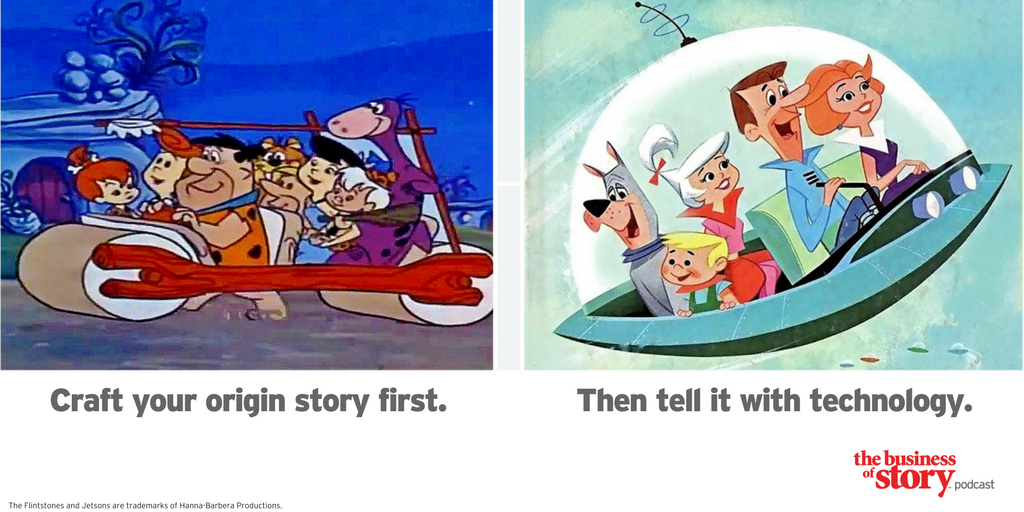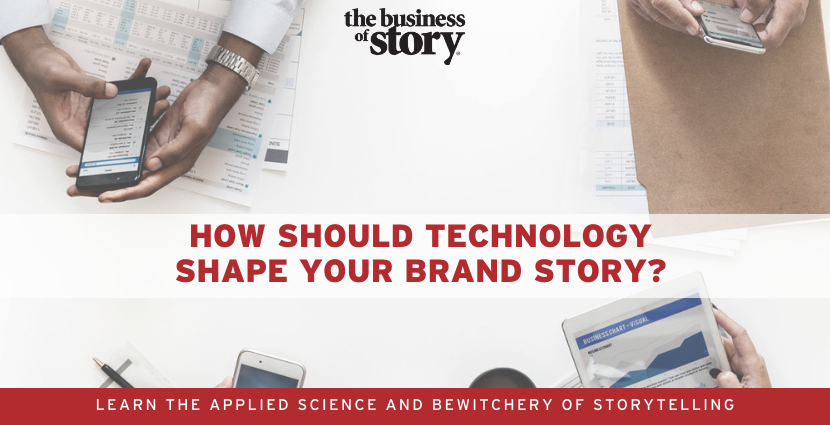Business storytelling is the strategic message in your content marketing, technology is its transmitter
As a kid, I loved the Flintstones and the Jetsons. Two great families with outstanding brands. The Flintstones are the (sing it with me) “Modern Stone Age Family.”
The Jetsons, on the other hand, are the space age family unit illustrated by George jettisoning “His boy Elroy, daughter Judy, and Jane, his wife,” from his Prius-like spaceship down to their respective destinations.
The internet has brought us Jetson-like communications advancement. But don’t get all starry-eyed over technology. Your brand story starts and ends with the primal foundations found with Fred and Wilma. Story is what has evolved us from cavemen to consumers. Technology is simply the transmitter of those stories.
For example, outdoor equipment retailer REI’s brand ethos – its primal story – is to get people outdoors. Their origin story had been around for decades before it started a movement with its #OptOutside campaign. REI simply used technology to amplify their “get people outdoors” story by encouraging us to not shop on Black Friday. Instead, spend that Friday after Thanksgiving outdoors with family and friends.
 You can hear the creator of REI’s #OptOutside campaign, Lee Einhorn, describe on the Business of Story podcast. He details how they developed the story first and then created a powerful brand movement using technology,
You can hear the creator of REI’s #OptOutside campaign, Lee Einhorn, describe on the Business of Story podcast. He details how they developed the story first and then created a powerful brand movement using technology,
AirBnB’s brand story is about helping people “Belong Anywhere.” They use tech to connect travelers with homeowners to make that happen.
Charles Schwab exists to help people achieve better financial outcomes for themselves and their families. They use their mobile app and online trading as an expression of their brand story making it easier to manage your wealth.
Technology provides the channels to tell your primal brand stories

Like George’s spaceship, technology is shiny. That’s why brands are quick to jump on the latest communication trends. In their haste, they often lose their humanity in the virtual world.
They bombard you with fleeting infographics. Listicles. Micro documentaries. Pins. Polls. Quizzes. Surveys. Memes. Gifs. Tweets. Snapchats. Instagrams. These brand blips whiz over long-form blogs, vlogs, videos, podcasts, eNewsletters, eBooks and emails in a meteor shower of competing messages.
Facebook, for instance, had an original mission “To give people the power to share and make the world more open and connected.” But it’s become what many consider an over-reaching advertising platform that invades your privacy. Users are turning away in droves for more authentic platforms like Instagram and SnapChat.
What brands forget in their universal fight to be heard is what makes them tick in the first place. People. We strive to connect and grow our communities online, but we miss the actual human interaction. Without it, our brand essence skips off the atmosphere and into deep, dark space.
What brings us home are true stories well told about the actual human impact your brand makes on this planet. Consider purpose-driven brands like CharityWater.org, Tesla’s launch of its more affordable Model 3 electric vehicle and Heineken’s #OpenYourWorld campaign.
Core brand stories share values, technology shares stories
“Marketing is about values,” said Apple founder, Steve Jobs. “It’s a complicated and noisy world, and we’re not going to get a chance to get people to remember much about us. So we have to be really clear about what we want them to know about us.”
How will Apple’s own technological mist-steps, including admitting to throttling back the performance of older iPhones to spur users to purchase its latest model? And the “dongleocalypse” it created by releasing its MacBook Pro with its USB Type-C adapter. It requires you purchase an $80 dongle to connect all of your existing devices. Talking about technology usurping a brand story.
So while your technology and communications channel options rocket ahead at an attention-numbing pace, stop and ask yourself: What does my brand stand for? Why do we exist? How do we actually help people accomplish something? What do we value?

Capture those narratives to clarify your brand position, define your promise, and declare your purpose. Craft them into meaningful, real-world stories that resonate with your people, your customers, and your stakeholders. Then deploy the wizardry of the web, with care, to share your brand stories with the world.
You see, the most innovative and effective way to brand yourself is not found in the latest technology. The branding advantage you want to take advantage of has been native to the human condition since the beginning of mankind.
Just tell a better story.
Yabadabadoo!
(This post originally appeared in the February 2018 edition of Greater Phoenix In Business Magazine: Selling You: Branding in the Age of Technology)











